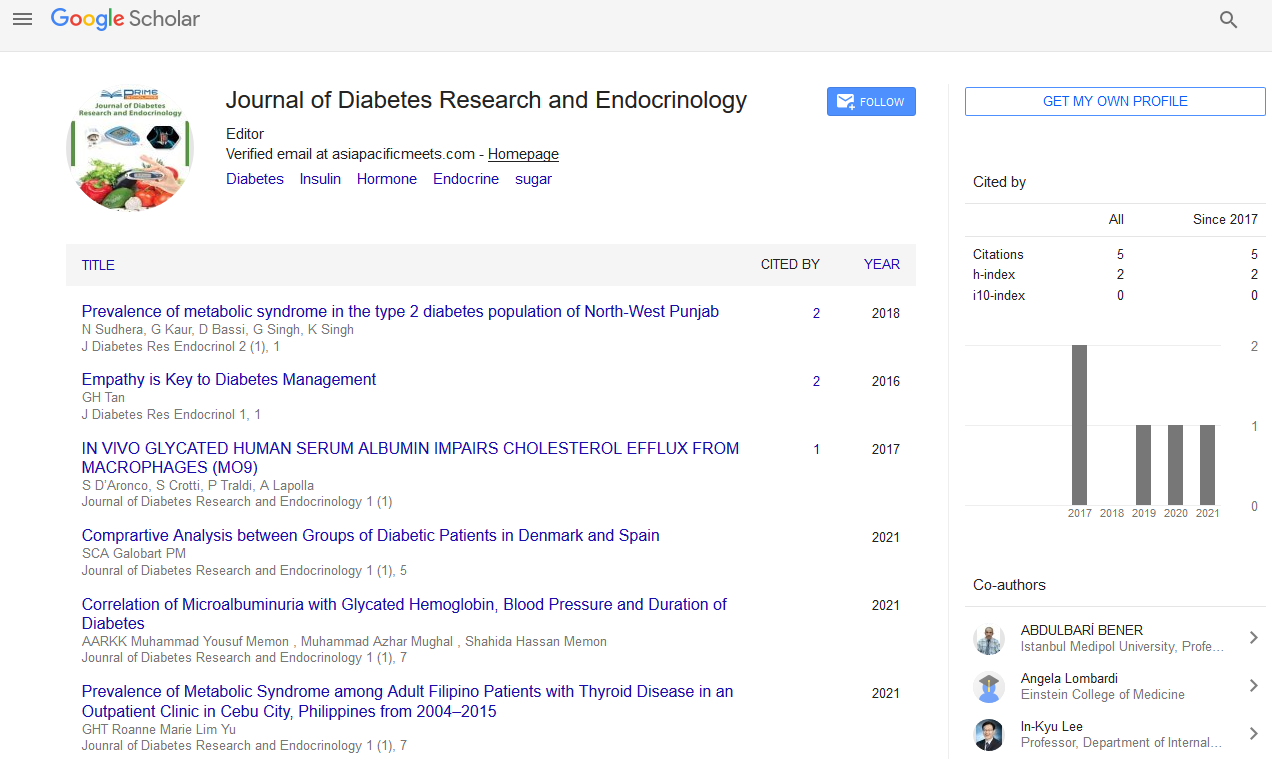Short Communication - (2024) Volume 8, Issue 2
Risk Factors and Prevention of Gestational Diabetes
Joseph Wood*
Department of Endocrinology, Stirling University, UK
*Correspondence:
Joseph Wood,
Department of Endocrinology, Stirling University,
UK,
Email:
Received: 29-May-2024, Manuscript No. IPJDRE-24-20953;
Editor assigned: 31-May-2024, Pre QC No. IPJDRE-24-20953 (PQ);
Reviewed: 14-Jun-2024, QC No. IPJDRE-24-20953;
Revised: 19-Jun-2024, Manuscript No. IPJDRE-24-20953 (R);
Published:
26-Jun-2024, DOI: 10.36648/ipjdre.08.02.12
Introduction
Gestational diabetes is a type of diabetes that develops during
pregnancy and usually disappears after giving birth. However,
it poses significant health risks to both the mother and the
baby. Understanding the risk factors and preventive measures
is crucial for managing this condition effectively. Women who
are overweight or obese have a higher risk of developing
gestational diabetes. Excess body fat can lead to insulin
resistance, making it harder for the body to regulate blood
sugar levels during pregnancy. The risk of gestational diabetes
increases with age, particularly for women over the age of
25. Older maternal age is associated with a greater likelihood
of developing insulin resistance. A family history of diabetes,
especially in first-degree relatives (parents or siblings),
significantly increases the risk. Genetic factors play a crucial
role in the development of gestational diabetes. Women who
have had gestational diabetes in a previous pregnancy are at a
higher risk of experiencing it again in subsequent pregnancies.
Women with PCOS, a hormonal disorder characterized by
irregular menstrual periods and polycystic ovaries, are more
prone to developing gestational diabetes [1,2].
Description
Certain ethnic groups, including African Americans, Hispanic/
Latino Americans, Native Americans, and Asian Americans, have
a higher predisposition to gestational diabetes. Women with
pre-existing high blood pressure or who develop high blood
pressure during pregnancy (preeclampsia) are at increased risk.
Lack of physical activity and a sedentary lifestyle contribute
to weight gain and insulin resistance, raising the likelihood of
gestational diabetes. Giving birth to a baby weighing more
than 9 pounds (4 kilograms) can be an indicator of gestational
diabetes in a previous pregnancy and a risk factor for its
recurrence. While some risk factors for gestational diabetes are
beyond control, several lifestyle modifications can help reduce
the risk Adopting a balanced diet rich in fruits, vegetables,
whole grains, and lean proteins is essential. Avoiding highsugar
and high-fat foods can help maintain healthy blood sugar
levels. It is advisable to eat smaller, frequent meals to prevent
blood sugar spikes. Engaging in regular physical activity, such
as walking, swimming, or prenatal yoga, can help regulate
blood sugar levels and improve insulin sensitivity. Aim for at
least 150 minutes of moderate exercise per week. Achieving
and maintaining a healthy weight before and during pregnancy
is crucial. Even a modest weight loss before pregnancy
can significantly reduce the risk of gestational diabetes.
Regular monitoring of blood sugar levels can help detect any
abnormalities early. This is especially important for women with
a history of gestational diabetes or other risk factors. Regular
prenatal visits are essential for monitoring the health of both
the mother and the baby. Early detection and management
of gestational diabetes can prevent complications. Smoking
and alcohol consumption can increase the risk of gestational
diabetes and other pregnancy complications. It is advisable
to avoid these substances during pregnancy. High stress
levels can affect blood sugar control. Practicing relaxation
techniques such as meditation, deep breathing exercises,
and prenatal massage can help manage stress. Participating
in diabetes education programs and seeking support from
healthcare providers, nutritionists, and support groups can
provide valuable information and encouragement. Gestational
diabetes is a manageable condition with the right preventive
measures and early intervention. Understanding the risk
factors and adopting a healthy lifestyle can significantly reduce
the risk of developing gestational diabetes. Regular prenatal
care and monitoring are vital to ensure the health and wellbeing
of both the mother and the baby. By taking proactive
steps, women can minimize the impact of gestational diabetes
and promote a healthy pregnancy [3,4].
Conclusion
Gestational diabetes, a condition that arises during pregnancy,
can pose risks to both mother and baby. Key risk factors include
obesity, age over 25, family history of diabetes, previous
gestational diabetes, and conditions like Polycystic Ovary
Syndrome (PCOS). Ethnic background, with higher prevalence in African American, Hispanic/Latino, Native American, and
Asian populations, also influences risk. A sedentary lifestyle,
high blood pressure, and having previously given birth to a
large baby further elevate the risk. Prevention focuses on
maintaining a healthy lifestyle. A balanced diet rich in fruits,
vegetables, whole grains, and lean proteins, coupled with
regular physical activity like walking or swimming, helps
manage weight and blood sugar levels. Regular prenatal care,
including blood sugar monitoring, is crucial for early detection
and management. Avoiding smoking, alcohol, and high-stress
levels also supports prevention. Through these measures,
the risk of gestational diabetes can be significantly reduced,
promoting a healthier pregnancy.
Acknowledgement
None.
Conflict Of Interest
The author’s declared that they have no conflict of interest.
References
- Kupriyanova Y, Patricia Zaharia O, Bobrov P, Karusheva Y, Burkart V, et al. (2021) Early changes in hepatic energy metabolism and lipid content in recent-onset type 1 and 2 diabetes mellitus. J Hepatol. 74(5):1028-1037.
[Crossref] [Google Scholar]
- Herder C, Furstos JF, Nowotny B, Begun A, Strassburger K, et al. (2017) Associations between inflammation-related biomarkers and depressive symptoms in individuals with recently diagnosed type 1 and type 2 diabetes. Brain Behav Immun. 61:137-145.
[Crossref] [Google Scholar]
- Ziegler D, Strom A, Bonhof G, Puttgen S, Bodis K, et al. (2018) Differential associations of lower cardiac vagal tone with insulin resistance and insulin secretion in recently diagnosed type 1 and type 2 diabetes. Metabolism. 79:1-9.
[Crossref] [Google Scholar]
- Roden M, Shulman GI (2019) The integrative biology of type 2 diabetes. Nature. 576(7785):51-60.
[Crossref] [Google Scholar]
Citation: Wood J (2024) Risk Factors and Prevention of Gestational Diabetes. J Diab Res Endocrinol. 8:12.
Copyright: 2024 Wood J. This is an open-access article distributed under the terms of the Creative Commons Attribution License, which permits unrestricted use, distribution, and reproduction in any medium, provided the original author and source are credited.

